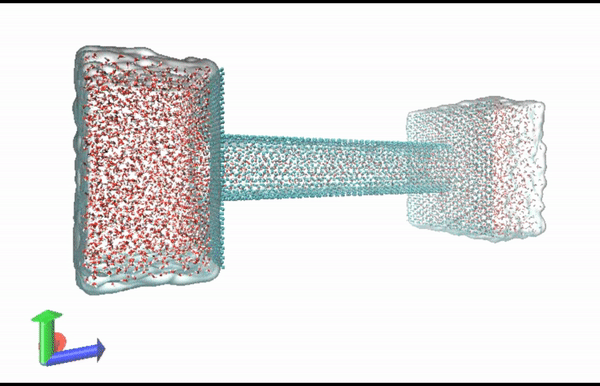Research
Constrained Actuator Line Model with Controls in a Entropic Lattice Boltzmann framework for Floating Offshore Wind Turbine simulations
Floating offshore wind turbines (fowts) differ fundamentally from bottom‑fixed units in that the rotor–nacelle assembly is supported by a moored floating platform. this configuration subjects the system to a coupled spectrum of aerodynamic, hydrodynamic, and mooring‑induced loads whose mutual interactions govern the platform motions and, ultimately, the turbine’s power performance and structural integrity. to address these challenges, we have developed a discrete‑element–inspired, multi‑rigid‑body actuator line model (alm) that captures the six‑degree‑of‑freedom dynamics of every major turbine and platform component while remaining computationally affordable for large‑scale, farm‑level simulations. the structural solver is tightly coupled, in a two‑way manner, to two lattice boltzmann solvers: an entropic lbm for the atmospheric flow field and a shallow‑water‑based lbm for the wave–current field. this dual‑lbm framework resolves the distinct time and length scales of air and water without resorting to overly restrictive grid refinements or time‑step constraints. the multi‑rigid‑body formulation eliminates the need for ad‑hoc inputs—such as prescribed rotational speed, blade‑pitch schedules, or yaw angles—that are inherent in conventional, one‑way‑coupled alms. instead, these operational variables emerge naturally from the balance of aerodynamic, hydrodynamic, gravitational, and mooring forces predicted by the solver. consequently, the methodology can reproduce transient phenomena such as turbine spin‑up from rest, platform surge‑pitch coupling, and wake evolution under realistic operating conditions. by embedding hydrostatic restoring forces and morison‑type hydrodynamic loads directly within the rigid‑body equations of motion, the proposed alm becomes applicable to a broad class of floating substructures—including spar, semi‑submersible, and tension‑leg platforms—without sacrificing numerical stability. the resulting toolset offers a unified, physics‑based approach for the aero‑hydro‑servo‑elastic analysis of fowts, paving the way for cost‑effective design optimization and array‑level performance assessment.link
Hydrodynamics of Acropora pulchra skeleton
Coral reef ecosystems are crucial for sustaining marine biodiversity and the global carbon cycle, with the framework building coral skeleton serving as the cornerstone of reef formation and stability. Coral skeletons, the fundamental units of this framework, are produced by coral polyps through biomineralization. They not only provide physical support and habitat for the polyps and other marine organisms but also sequester carbon through long term deposition. However, global climate change and human activities are intensifying ocean acidification, posing a serious threat to the physical mechanical properties and structural stability of coral skeletons. As atmospheric CO2 continues to rise, average seawater pH is projected to drop to 7.7 - 7.8 by 2100, with some areas falling below 6.8. This markedly weakens coral calcification, accelerates skeletal dissolution, and reduces mechanical strength and ecological resilience. In high energy hydrodynamic settings, the combined effects of acidification and flow may further exacerbate skeletal damage, heightening the risk of reef degradation. Yet studies on the physical mechanical behavior, hydrodynamic response, and cumulative long term dissolution of coral skeletons under acidified conditions remain limited, particularly those that analyze the evolution of complex pore structures and associated fluid transport mechanisms. Systematic investigation of skeletal microstructure, porosity, hydrodynamics, and dissolution effects under acidification is therefore essential for forecasting the long term impacts of ocean acidification and formulating coral protection and restoration strategies.link
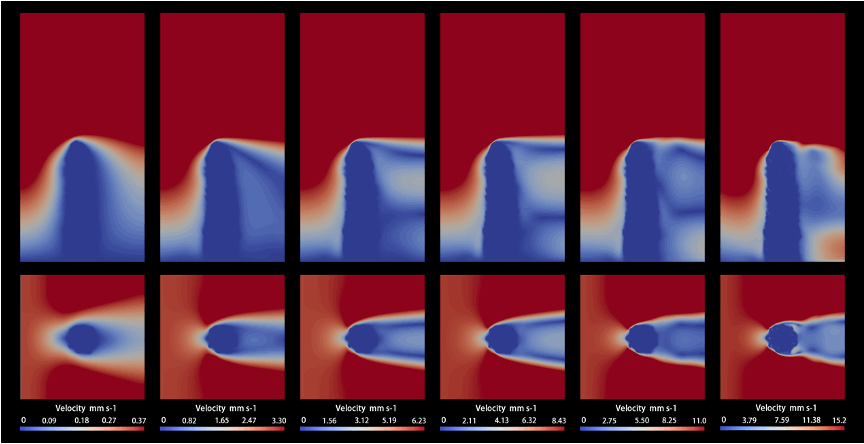
Dynamics and deposition morphology of granular column collapses
We investigated the collapse behavior of granular columns to better understand the dynamics and rheology of granular materials. In the preliminary study, we studied the collapse of dry granular columns, which results in various flow phenomena and deposition morphologies, which we link to the inter-granular and particle-boundary frictional coefficients and the initial aspect ratio of the granular columns. With the guidance of experiments, computational studies with the discrete element method (DEM) were performed to investigate the universality of dry granular column collapses. The resulting morphology of a collapsed granular column can be linked to an effective initial aspect ratio, and be described by different collapsing regimes, which are controlled by both the effective aspect ratio and the particle-boundary friction. The finding is important for understanding how granular materials, such as debris flows and landslides, behave and how they deposit when the granular flow halts.link
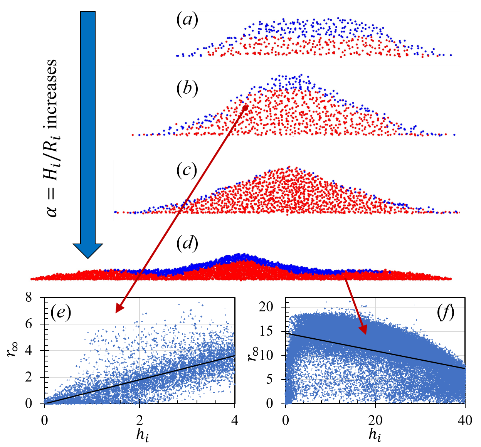
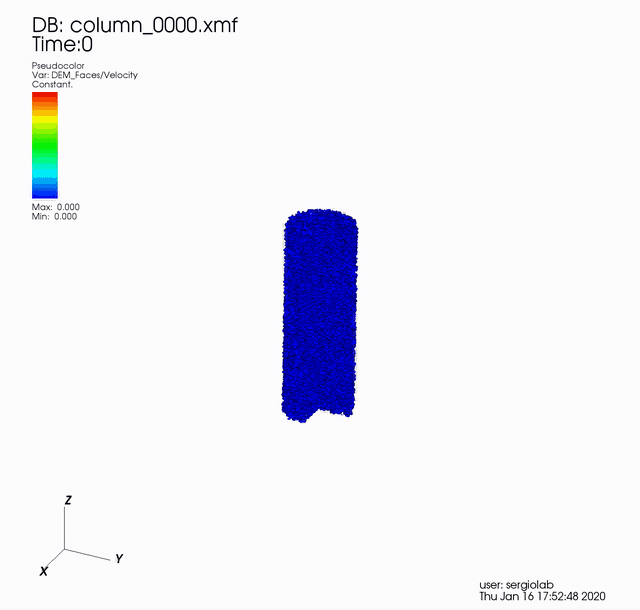
Size and Cross-section shape effect on granular column collapses
Based on previous works, we further aim to understand the size effect in granular column collapses. Geophysical hazards, such as landslides, debris flows, pyroclastic flows, and rock avalanches, occur frequently worldwide, and it is difficult to predict their initiation and dynamical behavior. Many geophysical flows can be considered as granular materials, where interaction between particles matters. However, it is difficult to upscale a grain-scale particle interaction to a large-scale predicting tool to capture the behavior of many complex granular flows. This paper starts from the collapse of granular columns, a fundamental problem often used to investigate the mobility of granular materials, and carefully navigates to examine the run-out behaviors of columns with different sizes, so that we can obtain a better picture of how different system sizes lead to different collapsing scenarios. We analyzed the characteristic length scale associated with the collapse of granular columns, and the strong force network presenting at the beginning of the collapse, to understand better what drives the size effect of granular systems, and what we can gain from this research to predict the behavior of geophysical flows.link
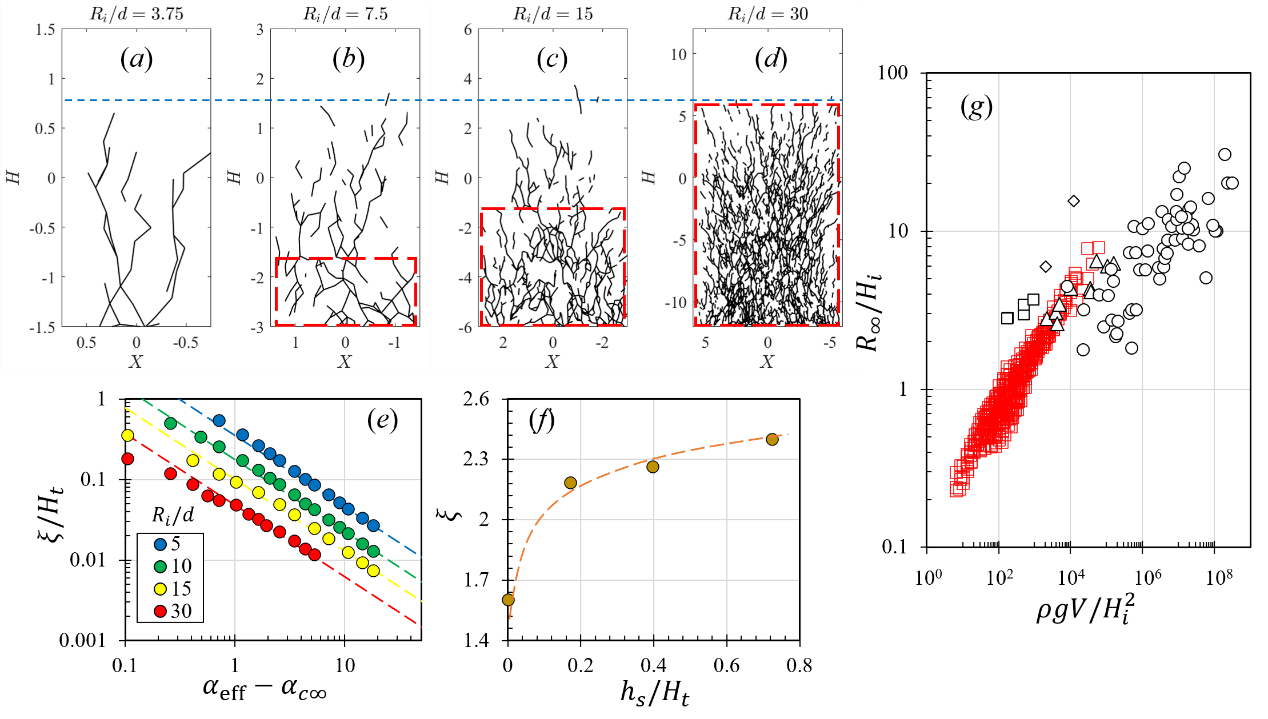
Response mechanism of sediments adsorption of pollutants to hydrodynamic conditions
Sediment in rivers and lakes play an important role in pollutant transport since pollutant can be absorbed by sediment or be released to water from sediment surface. Increasing fluid velocity can enhance or hinder adsorption which roughly depends on whether sediments suspend or not. The influence of hydrodynamic conditions on adsorption process is still not well understand. One challenging issue on modelling this process is: in conventional methods, the total amount of adsorbed pollutants is at the same magnitude (even lower) as numerical errors due to the moving particles. we introduced the Random Walking Method to solve pollutants transport with exact mass conservation. This improvement allows us to study the adsorption process at grain-scale. link
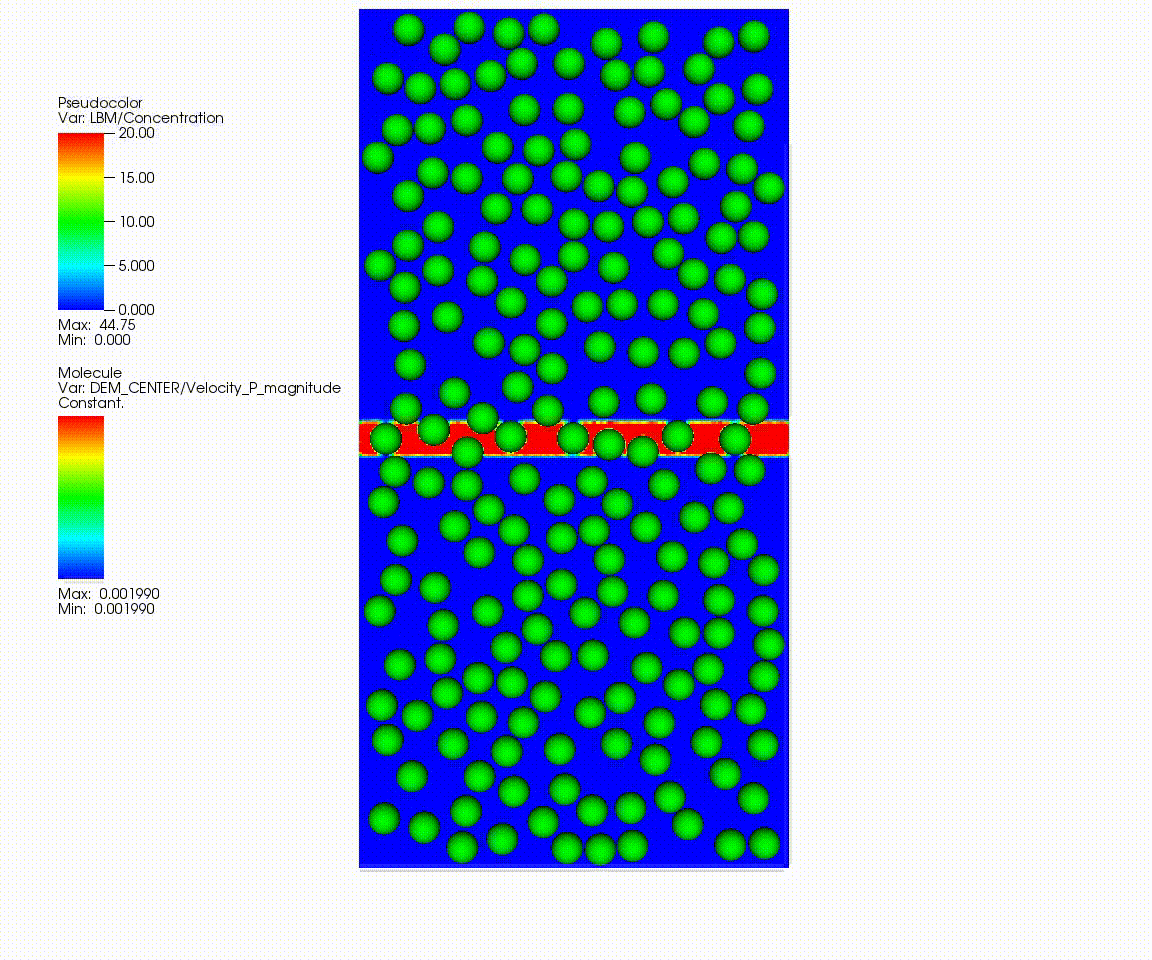
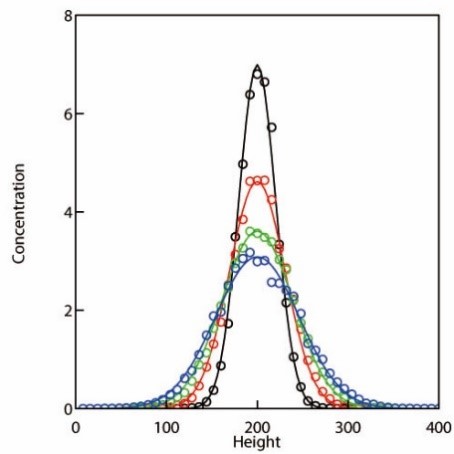
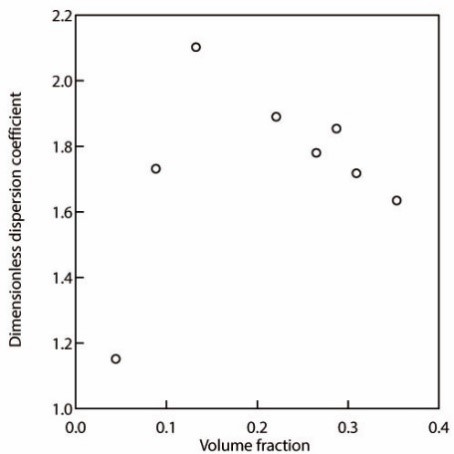
Solute transport in the fluid-particle system, particles are under periodic body force. Initial setup (left), Solute concentration porfile at different time step (middle), Dimensionless dispersion coefficient as a funtion of volume fraction (right).
Debris flow modelling
Debris flow is a type of mass movement that is generated under certain mechanical conditions of the soil and external factors as weather, seismic and anthropic activity. The water-sediment interaction processes dominate the behaviour of the flow while is driven by gravity. The sediments size have a broad spectrum from fine grains to big boulders (up to ~11 m in diameter). The dynamic of the interaction of these big boulders with the entire flow is not well known. And, reliable predictions of the dynamics of these phenomena is crucial for risk management.Thus, Smooth Particles Hydrodynamics (SPH) coupled to Discrete Element Method (DEM), are employed in this project to model debris flows link.
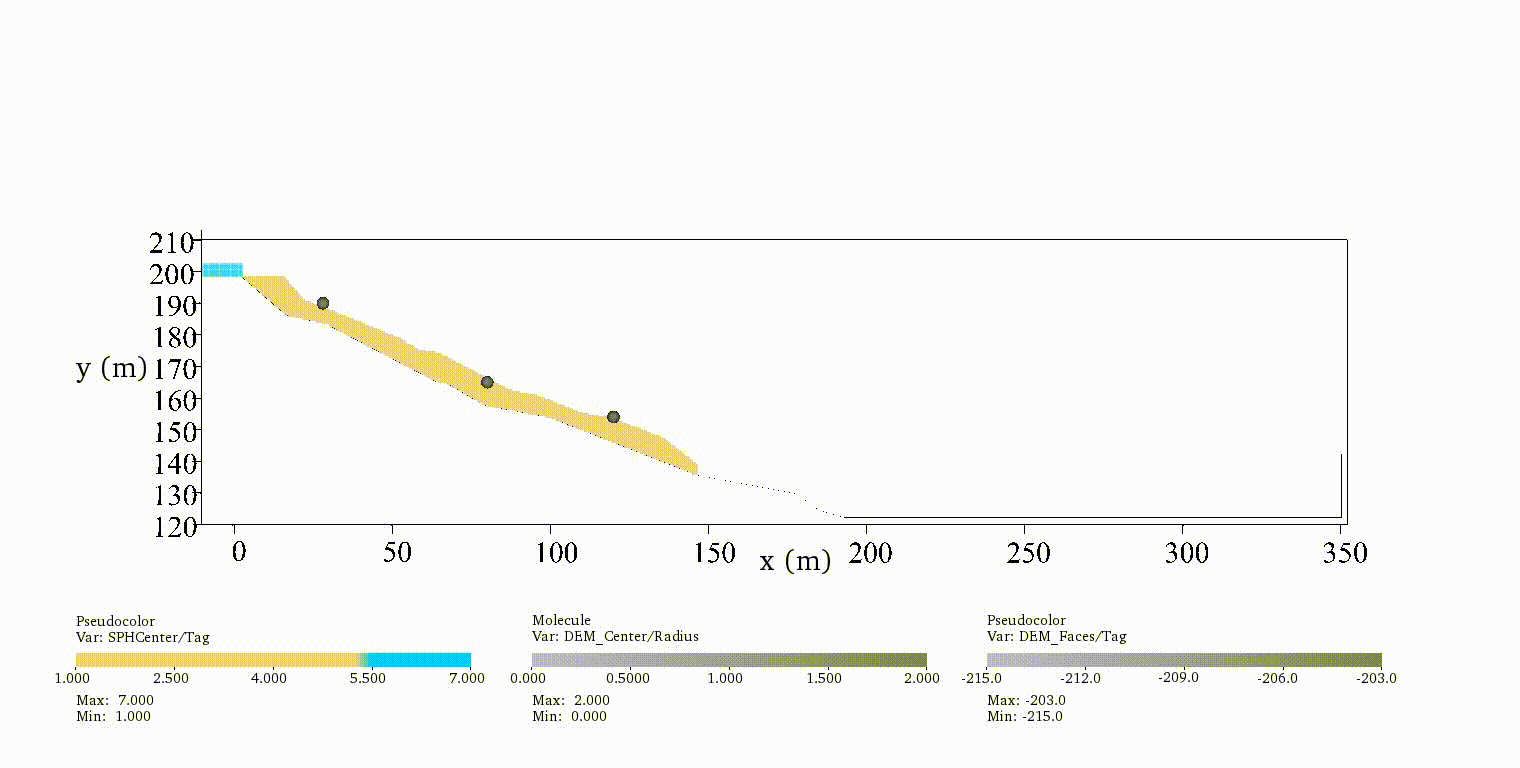 SPH to represent water and soil components, whereas DEM is used to include large size boulders).
SPH to represent water and soil components, whereas DEM is used to include large size boulders).
 Fluid–solid–particle systems such as rapid mixed flow are very common in steep mountainous regions and have the potential to damage infrastructures. Baffles are typically used as flow-impeding structures to mitigate the destructive power of this natural hazard. However, modelling these complex interactions is still very challenging due to their multi-phase and multi-scale nature. Therefore, we have developed a hybrid model that combines the advantages of the two-phase (solid and liquid) Material Point Method (MPM) on handling continuum materials (fluids and soils) with large deformations and the capability of the Discrete Element Method (DEM) on simulating the mechanical behaviours of rigid particles (rocks). link.
Fluid–solid–particle systems such as rapid mixed flow are very common in steep mountainous regions and have the potential to damage infrastructures. Baffles are typically used as flow-impeding structures to mitigate the destructive power of this natural hazard. However, modelling these complex interactions is still very challenging due to their multi-phase and multi-scale nature. Therefore, we have developed a hybrid model that combines the advantages of the two-phase (solid and liquid) Material Point Method (MPM) on handling continuum materials (fluids and soils) with large deformations and the capability of the Discrete Element Method (DEM) on simulating the mechanical behaviours of rigid particles (rocks). link.
Invariant forms for the permeability and transport properties of discrete fracture networks
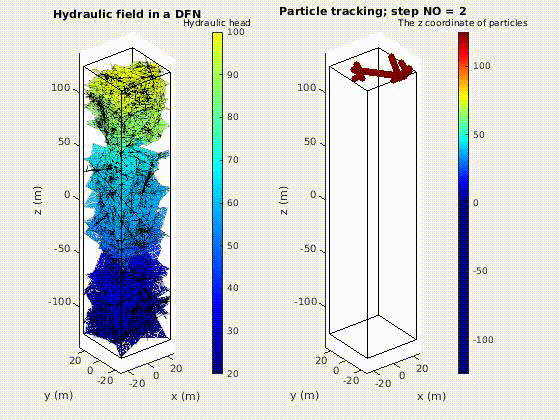 Translating fracture statistics to global hydraulic properties in subsurface fractured rocks is a complex but appealing task, as measuring parameters such as permeability can be prohibitively expensive. To tackle this challenge, we developed the finite-size scaling (FSS) hypothesis, drawing inspiration from percolation theory in statistical physics. We created numerous Monte Carlo iterations using our CUDA-based code, cuDFNsys, to simulate flow and transport in discrete fracture networks (DFNs), as shown in the figure below. We generated a wide range of DFN scenarios with vastly different input parameters to ensure generality. We then nondimensionalized the obtained connectivity, permeability, density of fractures, domain sizes, and so on. By analyzing the dimensionless quantities, we found that the FSS hypothesis can accurately predict connectivity and permeability as an invariant function of dimensionless density and domain sizes with several universal critical quantities. Furthermore, the FSS function can identify the transition point of dimensionless density, where permeability remains constant regardless of domain sizes. Around this point, the scale-dependence of permeability changes from negative to positive. Our findings provide a strong theoretical foundation for understanding the relationship between fracture attributes and field-scale hydraulic properties. This research inspires further investigation into applying the FSS function at the field scale, which will improve the information that earth scientists can obtain from fracture statistics link.
Translating fracture statistics to global hydraulic properties in subsurface fractured rocks is a complex but appealing task, as measuring parameters such as permeability can be prohibitively expensive. To tackle this challenge, we developed the finite-size scaling (FSS) hypothesis, drawing inspiration from percolation theory in statistical physics. We created numerous Monte Carlo iterations using our CUDA-based code, cuDFNsys, to simulate flow and transport in discrete fracture networks (DFNs), as shown in the figure below. We generated a wide range of DFN scenarios with vastly different input parameters to ensure generality. We then nondimensionalized the obtained connectivity, permeability, density of fractures, domain sizes, and so on. By analyzing the dimensionless quantities, we found that the FSS hypothesis can accurately predict connectivity and permeability as an invariant function of dimensionless density and domain sizes with several universal critical quantities. Furthermore, the FSS function can identify the transition point of dimensionless density, where permeability remains constant regardless of domain sizes. Around this point, the scale-dependence of permeability changes from negative to positive. Our findings provide a strong theoretical foundation for understanding the relationship between fracture attributes and field-scale hydraulic properties. This research inspires further investigation into applying the FSS function at the field scale, which will improve the information that earth scientists can obtain from fracture statistics link.
Realistic shapes for fluid immersed particle simulations
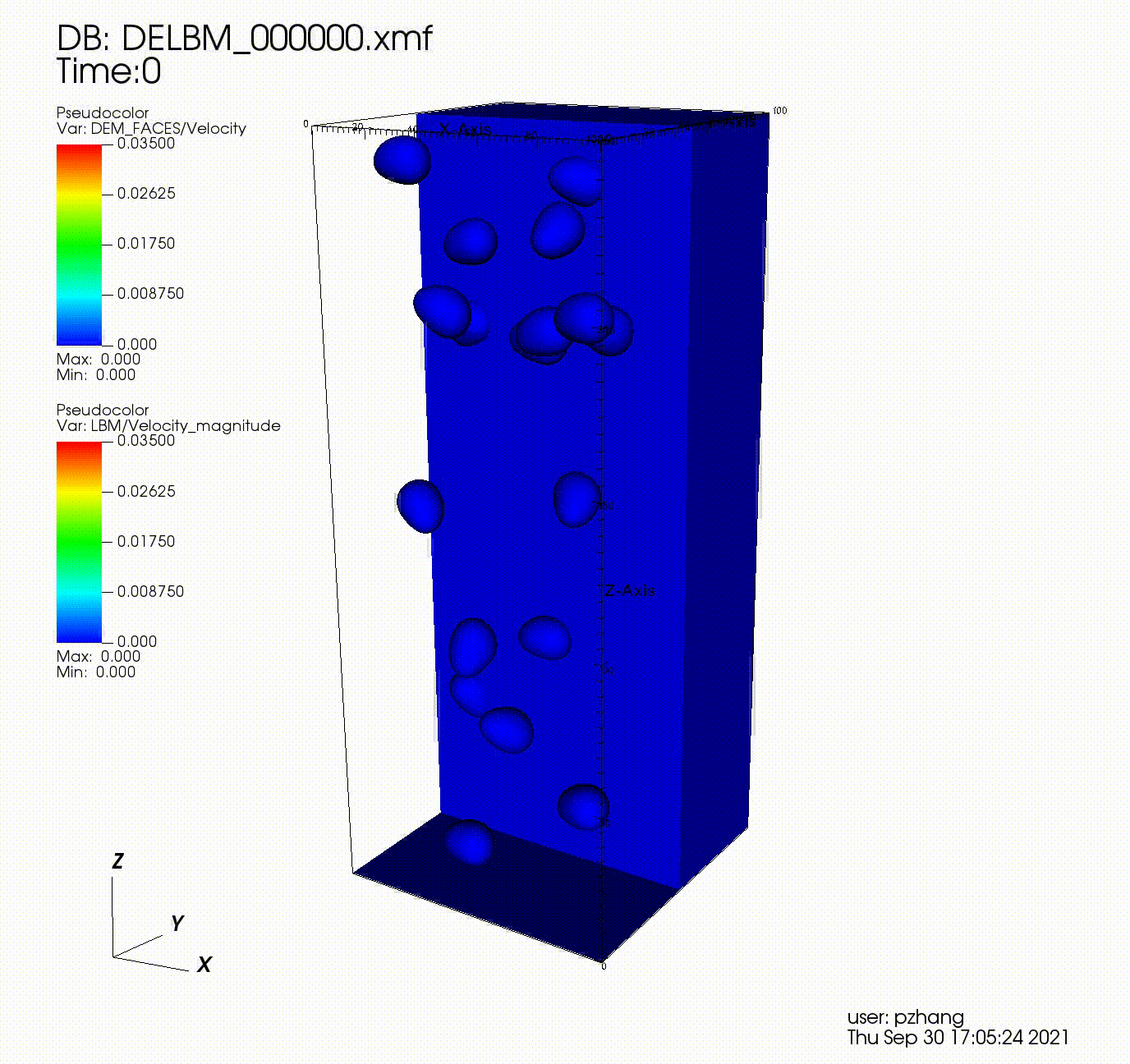 We developed a Metaball-Imaging (MI) based Discrete Element Lattice Boltzmann Method (DELBM) for simulations of fluid-particle systems with irregular-shaped particles. The MI algorithm was used to capture the real grain shape for simulations with Metaballs, which are coupled in the DELBM framework. The core challenge, contact detection, was tackled robustly by gradient calculation of the closest point with a Newton-Raphson based scheme. The proposed model is rigorously validated with multiple experiments, including analytical solutions and cases of irregular-shaped granular media immersed in fluid systems. Results show that the proposed model is effective and powerful in probing the micromechanics of these systems. Furthermore, the model's potential for studying shape-induced physical processes is investigated, demonstrating its usefulness in fluid-particle system research. The study's main contribution is its ability to simulate complex-shaped particles, which is a difficult task in the field of fluid-particle system simulations.link.
We developed a Metaball-Imaging (MI) based Discrete Element Lattice Boltzmann Method (DELBM) for simulations of fluid-particle systems with irregular-shaped particles. The MI algorithm was used to capture the real grain shape for simulations with Metaballs, which are coupled in the DELBM framework. The core challenge, contact detection, was tackled robustly by gradient calculation of the closest point with a Newton-Raphson based scheme. The proposed model is rigorously validated with multiple experiments, including analytical solutions and cases of irregular-shaped granular media immersed in fluid systems. Results show that the proposed model is effective and powerful in probing the micromechanics of these systems. Furthermore, the model's potential for studying shape-induced physical processes is investigated, demonstrating its usefulness in fluid-particle system research. The study's main contribution is its ability to simulate complex-shaped particles, which is a difficult task in the field of fluid-particle system simulations.link.
Mass transfer around a rising bubble
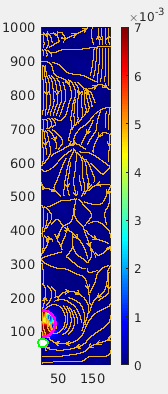 In this project, we focused on the mass transfer process around a rising bubble, utilizing a pseudopotential Lattice Boltzmann Model (LBM) simulation. In contrast to previous studies that assumed bubble rising through an effective buoyancy force, we developed an LBM that accounts for the actual buoyancy force stemming from the pressure gradient. By applying thermodynamic analysis to the multi-component pseudopotential LBM, we established an initial (mechanical and chemical potential) equilibrium state and interpretated the Henry law from the viewpoint of chemical potential balance. We implemented our LBM code to model bubble rising in both saturated and unsaturated solutions. Our results unveiled a significant correlation between the diffusion (Figure 1) and advection processes (Figure 2). Specifically, at the lateral side of the rising bubble, the strong advection process continually refreshes the bubble surface, creating a large concentration gradient and, consequently, a strong diffusion process. Conversely, at the bottom side of the bubble, the advection is relatively weak or even negligible, leading to the accumulation of saturated solution in that area and, therefore, weak or negligible diffusion process. Additionally, our LBM code satisfactorily simulates various bubble shapes and their respective distribution of diffusion zones, as demonstrated in Figure 3. We observed a critical point on the bubble surface where the radius of curvature reaches a minimum. This point effectively separates the bubble surface into two parts, with one side experiencing a strong diffusion process and the other side exhibiting negligible diffusion. These findings provide valuable insights into the mass transfer mechanism around a rising bubble and are expected to enhance the penetration theory to account for the effects of bubble shapes and wakes. This work has been published on the journal of Physics of Fluids.link
In this project, we focused on the mass transfer process around a rising bubble, utilizing a pseudopotential Lattice Boltzmann Model (LBM) simulation. In contrast to previous studies that assumed bubble rising through an effective buoyancy force, we developed an LBM that accounts for the actual buoyancy force stemming from the pressure gradient. By applying thermodynamic analysis to the multi-component pseudopotential LBM, we established an initial (mechanical and chemical potential) equilibrium state and interpretated the Henry law from the viewpoint of chemical potential balance. We implemented our LBM code to model bubble rising in both saturated and unsaturated solutions. Our results unveiled a significant correlation between the diffusion (Figure 1) and advection processes (Figure 2). Specifically, at the lateral side of the rising bubble, the strong advection process continually refreshes the bubble surface, creating a large concentration gradient and, consequently, a strong diffusion process. Conversely, at the bottom side of the bubble, the advection is relatively weak or even negligible, leading to the accumulation of saturated solution in that area and, therefore, weak or negligible diffusion process. Additionally, our LBM code satisfactorily simulates various bubble shapes and their respective distribution of diffusion zones, as demonstrated in Figure 3. We observed a critical point on the bubble surface where the radius of curvature reaches a minimum. This point effectively separates the bubble surface into two parts, with one side experiencing a strong diffusion process and the other side exhibiting negligible diffusion. These findings provide valuable insights into the mass transfer mechanism around a rising bubble and are expected to enhance the penetration theory to account for the effects of bubble shapes and wakes. This work has been published on the journal of Physics of Fluids.link
Submmerged granular column collapses
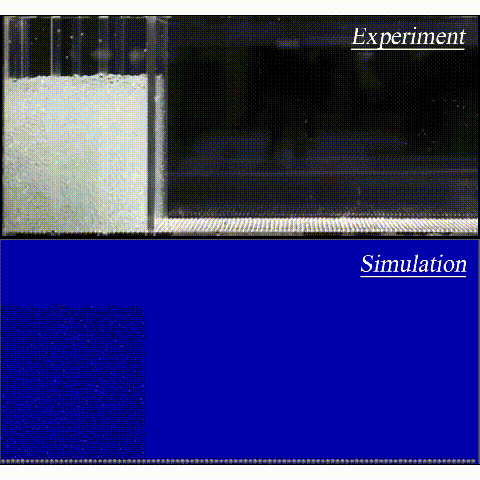 The occurrence of submarine landslides can have a significant impact on our lives, both directly and indirectly. This large-scale natural phenomenon involves multiple scales and phases and can result in the transportation of large amounts of sediment over long distances, causing damage to submerged structures such as pipelines, and offshore oil wells, and even leading to tsunamis. However, investigating the initiation, propagation, and deposition of submarine landslides directly can be a challenging task.
The occurrence of submarine landslides can have a significant impact on our lives, both directly and indirectly. This large-scale natural phenomenon involves multiple scales and phases and can result in the transportation of large amounts of sediment over long distances, causing damage to submerged structures such as pipelines, and offshore oil wells, and even leading to tsunamis. However, investigating the initiation, propagation, and deposition of submarine landslides directly can be a challenging task.
To address this issue, we developed an LBM-DEM numerical model to replicate submerged granular column collapses at a laboratory scale and examine their underlying mechanisms. The insights gained from this study can be applied to predict macroscopic submarine landslides more accurately.
Molecular dynamic simulations of flow inside carbon nanotubes (CNT)
We investigate nano-mechanical transport mechanisms and intermolecular structure of nanofluids to better understand and develop water desalination based nanomaterials. In a preliminary study, we have investigated the flow enhancement of nanoconfined water in the carbon nanotube (CNT), which is contributed by the various scale and different force fields. We connect the above contributions to various intermolecular structures and different fluid states. According to previous experiments and simulations, we have studied the flow enhancement inconsistencies through molecular dynamics (MD) simulations. MD simulations indicate that the inconsistency of pressure-dependent flow enhancements can be attributed to the liquid structure, and quantitatively analyzed the structural properties through calculate the apparent friction coefficient, which are affected by the external force field. This finding will help us understand the flow enhancement inconsistencies and improve the water permeability efficiency of desalination.
